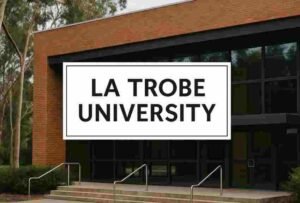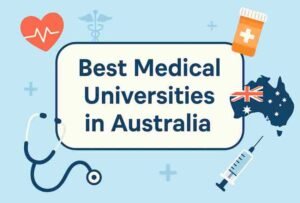Study in Australia
Australia offers top universities and global courses. Students enjoy a safe and multicultural lifestyle. Stubard helps with admissions, visas, and living arrangements. We make your move to Australia easy and worry-free.

Study Abroad in Australia: A Guide for Global Students
So, you’re thinking about studying in Australia? That’s a pretty solid move, honestly. In 2023 alone, over 786,891 international students picked Australia as their study destination. That is not a small number and when you see what the country offers, it adds up.
You’ve got some of the world’s best universities, like the University of Melbourne and Australian National University. The classes don’t just dump theory on you. They’re hands-on, career-focused, and taught in English. And yes, that degree you’re chasing? It’s recognised globally, which means real value for your time and money.
But here’s the thing, it’s not just about academics. Life in Australia? It’s got this easy-going vibe. The people are chill, the cities are clean, and it feels pretty safe, especially if you are moving away from home for the first time. Whether you are in Sydney, Melbourne, or Brisbane, there’s always something happening; beaches, gigs, part-time work, or late-night study café runs.
This guide is your walkthrough from picking your uni to figuring out that visa stuff. Just take it one step at a time. You don’t need to have it all figured out right now. You just need a start and maybe this is it.
Why Should You Study in Australia as an International Student?
So, what’s the big deal about Australia? Why are students from every corner of India, Nepal, Nigeria, Vietnam, making their way down under?
It’s not just the sunshine and surf (though, let’s be honest, that’s a pretty sweet bonus). It’s because Australia offers the full package; world-class education, practical learning, and a lifestyle that feels just right.
Let’s break it down:
Globally respected universities
Universities like the University of Sydney, Monash, and ANU aren’t just high in rankings. They actually prepare you for real-world careers. And most degrees are internationally recognised, meaning you can work anywhere after.
Work while you study
Got bills? Australia’s got you. Student visa holders can now work up to 48 hours every two weeks during semesters. That helps, big time.
Post-study work rights
Depending on your course and city, you can stay back and work for up to 2 to 6 years. Not every country offers that kind of flexibility.
Multicultural & English-speaking
With 200+ cultures across the country, you won’t feel out of place. Plus, daily life runs in English classes, jobs, and even your coffee orders.
Top quality of life
Australia is ranked among the top for student satisfaction, safety, healthcare, and clean cities. You’ll find friendly folks, reliable public transport, and beach sunsets after class.
Practical learning approach
It’s not all theory here. Think internships, industry connections, and hands-on training built into your degree. That’s gold for your CV.
Bottom line? If you’re looking for more than just a classroom, if you want a degree that gives you skills, confidence, and global opportunities, Australia makes a whole lot of sense.
Quick Facts
Category | Details |
Capital | Canberra |
Popular Student Cities | Sydney, Melbourne, Brisbane, Perth, Adelaide |
Official Language | English |
Total International Students | 786,891 (as of 2023 – Source: Australian Government Department of Education) |
Number of Universities | 43 public universities + private institutions |
Top-Ranked Universities | University of Melbourne, ANU, UNSW, University of Sydney |
Popular Courses | Business, Engineering, IT, Healthcare, Design, Environmental Sciences |
Tuition Fees | AUD 20,000 – 45,000/year (UG), AUD 22,000 – 50,000/year (PG) |
Living Cost (Monthly) | AUD 1,400 – 2,500 depending on city and lifestyle |
Main Intakes | February, July (some courses in November) |
Scholarship Options | Australia Awards, Destination Australia, RTP, Uni-specific awards |
What Is the Education System Like in Australia?
Australia’s education system is built to give you flexibility, practical skills, and globally recognised qualifications. Whether you’re aiming for a bachelor’s, master’s, or PhD, there’s a clear structure and it’s all in English, which makes the transition smoother for international students.
Here’s how it works:
Level of Study | Duration | Details |
Bachelor’s Degree | 3–4 years | Common options: Arts, Business, Science, Engineering. Some courses include an honours year. |
Master’s Degree | 1–2 years | Can be coursework-based or research-focused. Designed to deepen your expertise or help you switch fields. |
PhD/Doctoral Programs | 3–4 years | Research-intensive with the option for teaching or publication-based completion. Scholarships are often available. |
VET Courses | 6 months–2 years | Vocational Education and Training (VET) programs offer hands-on, industry-ready skills: ideal for trades, hospitality, IT, etc. |
Most universities follow a semester system, starting in February and July, though some offer trimesters. Classes follow a credit-based format, so you’ll need to complete a set number of units to graduate.
What sets Australia apart? You’ll find:
- Real-world learning through internships and group projects
- Pathways between VET and university programs
- Global recognition of degrees across 100+ countries
According to QS Rankings 2025, 43 Australian universities are ranked globally, showing strong academic reputation and employability outcomes.
What Are the Top Courses to Study in Australia?
If you’re wondering what to study in Australia, you’re not alone. With so many choices, it can feel a bit overwhelming. But let’s break it down. Australia is famous for courses that don’t just sound good on paper. They actually lead to real careers.
Here’s what students usually go for:
- Business and Management – Always in demand. Plus, Aussie unis offer global exposure and internship options.
- Engineering – Civil, Mechanical, Mining, and Software Engineering are strong here. Unis like UNSW and Monash are top picks.
- Information Technology – From AI to cybersecurity, Australia’s tech courses are future-ready.
- Health and Nursing – Big demand in both local and global job markets.
- Hospitality and Tourism – Makes sense, right? Australia’s a tourist magnet.
- Environmental Science – With Australia’s natural diversity, this field is gaining ground fast.
- Education and Teaching – High-quality training, plus a solid need for qualified educators.
Many programs come with industry placements, giving you that “real world” edge. And the best part? Over 80% of international students in Australia say their education helped them land better jobs later. That’s not just talk, it’s a proven path.
What Are the Admission Requirements to Study in Australia?
So, you’re thinking about applying to an Australian university? Good choice. But before you start packing your bags, you’ve gotta know what unis down under expect from you.
Let’s keep it simple.
For Undergraduate (Bachelor’s) Degrees:
- You need to have completed Class 12 or equivalent with decent scores. Most unis look for 60–70% or higher, but it really depends on the course and uni.
- English proficiency is a must. IELTS, TOEFL, or PTE Academic scores are commonly accepted.
- Some programs like design or architecture might ask for a portfolio too.
For Postgraduate (Master’s) Degrees:
- A bachelor’s degree in a related field is essential.
- Some competitive courses like MBA may need work experience (2+ years) and GMAT scores.
- Again, you’ll need proof of English skills, IELTS is standard for most.
Many universities now accept a MOI letter if your previous education was in English. But double-check some still prefer official test scores.
Applying early helps. Intakes usually fill fast. You don’t wanna be that person chasing deadlines last minute.
Document Checklist to Apply for Australian Universities
If you’re applying to study in Australia, here’s what you’ll need to keep handy:
- Valid Passport (should be valid for the duration of your course)
- Academic Transcripts (Class 10, 12, or Bachelor’s mark sheets and certificates)
- Proof of English Proficiency (IELTS, TOEFL, PTE, or MOI letter)
- Statement of Purpose– why you want to study the course and your future plans
- Letters of Recommendation – usually 1–2 from teachers or employers
- Resume/CV – needed for postgrad and professional programs
- Portfolio (for courses in design, arts, architecture, etc.)
- Proof of Funds – bank statements or sponsor letters to show you can cover tuition and living costs
- Work Experience Letters (only if the course requires it, like an MBA)
- Copy of Offer Letter (after acceptance for visa filing)
- Visa Documents (after admission – includes OSHC, visa application form, etc.)
What Are the Student Visa Requirements for Studying in Australia?
Alright, so you’ve been accepted into an Australian university, that’s great! But before packing your bags, you’ve gotta sort your visa. Yes, Australia takes its visa process seriously, but don’t stress. If you’ve got your stuff in order, it’s pretty straightforward.
You will need a Subclass 500 Student Visa to study in Australia. It basically lets you stay in the country while you are completing your course. You can also work part-time, which is a big win for most students.
Here’s what you need:
Passport
Obvious, right? Just make sure it’s valid during your whole stay. If it’s expiring soon, renew it before applying.
Confirmation of Enrolment
Your university gives you this after you accept the offer. No CoE, no visa.
GTE Statement
That’s the Genuine Temporary Entrant letter. Sounds fancy, but it is just a short piece where you explain why you’re studying in Australia and that you are planning to return home after your degree.
Proof of Funds
You need to show you’ve got enough money to live in Australia and pay tuition. As of now, that’s about AUD 24,505 per year for living costs. You can show bank statements or a scholarship letter.
English Language Test
Most students need IELTS, TOEFL, or PTE scores. Aim for an IELTS score of 6.0 or above, unless your course asks for more.
Overseas Student Health Cover (OSHC)
This is non-negotiable. You have gotta have health insurance that covers you for your entire stay.
Medical Checks and Biometrics
Depending on where you are from, you might be asked to go for a health check or give fingerprints.
Application Fee
Currently around AUD 710. It might change, so always check the official immigration website.
Apply for your visa at least 6–8 weeks before your course begins. Delays can happen, especially close to major intakes.
With this visa, you can work up to 48 hours per fortnight during semesters and full-time during breaks, great for managing living costs.
How Much Does It Cost to Study in Australia?
Thinking of studying in Australia? It’s not exactly cheap, but totally doable if you plan things out smartly. On average, you’re looking at spending anywhere between AUD 20,000 to 54,000 a year depending on what you’re studying and where. Courses like humanities or arts usually cost less, while stuff like engineering, medicine or law can hit the higher end. Some top unis may charge more, obviously. But don’t panic, a lot of students manage just fine by budgeting and applying for scholarships. Just make sure to check the uni’s official fee page, ’cause the numbers change and sometimes there are extra costs like lab work or materials. If you’re serious about it, this is something you’ll wanna sort early in your planning.
Tuition Fees in Australia for International Students
Level of Study | Typical Tuition Range (AUD/year) |
Bachelor’s Degree | 20,000 – 50,000 |
Master’s Degree | 22,000 – 54,000 |
Doctoral Programs (PhD) | 14,000 – 37,000 |
MBA (High-end Business) | 40,000 – 70,000 |
What Is the Cost of Living in Australia for Students?
Living in Australia as an international student isn’t exactly cheap, but it’s not outrageous either if you plan smartly. On average, you will need about AUD 1,400 to AUD 2,500 per month, depending on where you live and your lifestyle. Cities like Sydney and Melbourne are on the higher side, while Adelaide, Perth, and Hobart are more affordable.
Know more about the Cost of living in Australia.
Let’s break it down a bit.
Let’s break it down a bit.
Category | Monthly Cost (AUD) |
Rent (shared flat) | 600 – 1,200 |
Groceries | 300 – 600 |
Transport | 100 – 200 |
Utilities & Internet | 100 – 150 |
Leisure/Misc | 150 – 300 |
Total Estimate | 1,400 – 2,500 |
Which Are the Best Universities in Australia for International Students?
Australia is home to some of the world’s most respected universities, and international students absolutely love the mix of quality education and a relaxed, multicultural lifestyle. According to the QS World University Rankings 2025, several Australian universities consistently make it into the top 100 globally.
Top Universities in Australia for International Students
University Name | QS World Rank 2025 | Type | Avg Tuition Fees (AUD/year)* |
University of Melbourne | 13 | Public Research | 20,000 – 45,000 |
University of New South Wales (UNSW Sydney) | 19 | Public Research | 20,000 – 45,000 |
University of Sydney | =25 | Public Research | 20,000 – 45,000 |
Australian National University (ANU) | =32 | Public Research | 22,000 – 50,000 |
Monash University | =36 | Public Research | 20,000 – 45,000 |
University of Queensland | =42 | Public Research | 20,000 – 45,000 |
University of Western Australia | 77 | Public Research | 20,000 – 45,000 |
University of Adelaide | =82 | Public Research | 20,000 – 45,000 |
University of Technology Sydney (UTS) | 96 | Public Tech/Research | 18,000 – 40,000 |
RMIT University | 125 | Public Tech/Research | 18,000 – 40,000 |
These universities not only offer world-class teaching and research, but also a friendly, safe environment that feels like home for many students from India, Southeast Asia, and beyond.
What Scholarships Are Available to Study in Australia?
Thinking about studying in Australia but stressed about the costs? Totally understandable. But here’s the good news, Australia offers a bunch of scholarships that can make your dream way more affordable. Whether you’re applying for undergrad, postgrad, or research, there’s something out there to help lighten the load.
These scholarships are offered by the Australian government, universities, and even some private organisations. Some cover just tuition, while others throw in living costs, travel, and health insurance too.
Here’s a quick breakdown of the top ones you should know about:
Scholarship Name | Who Can Apply | What It Covers |
Australia Awards Scholarships | Students from developing countries (incl. India, Sri Lanka, Nepal) | Full tuition, living expenses, travel, health insurance |
Destination Australia Scholarships | Domestic and international students | Up to AUD 15,000 per year for studying in regional areas |
Research Training Program (RTP) | Masters by research and PhD candidates | Tuition fee offset + stipend for living costs |
University-Specific Scholarships | Varies (Merit-based/Need-based) | Partial to full tuition, depending on university |
ACIAR Fellowships | Agriculture and science grads from partner countries | Tuition + return airfare + stipend |
Popular University Scholarships:
- University of Melbourne Graduate Research Scholarships – Full tuition + AUD 34,400/year living stipend
- UNSW International Scholarships – Up to AUD 20,000
- ANU Chancellor’s International Scholarship – 25–50% fee reduction
- Monash International Merit Scholarship – Up to AUD 10,000 per year
Tip: Apply early. Most scholarships have limited seats and competitive deadlines.
Need help shortlisting ones you qualify for? Let me know your course and university picks, and I’ll guide you further.
When Are the Intakes to Study in Australia?
Let’s talk about when you can start your study journey in Australia. Timing matters, and knowing the right intake can make a big difference in terms of course availability, visa processing, and even scholarship options.
So here’s the intake in Australia:
Main Intakes
- February (Semester 1)
- This is the big one. Most students, especially from countries like India, Nepal, and Bangladesh, aim for this intake.
- Almost 80% of courses are open during this time.
- Universities are buzzing, more scholarships are available, and support services are in full swing.
- July (Semester 2)
- Not as packed as February, but still solid.
- You will find many undergrad and postgraduate programs open here too.
- It’s a great choice if you miss the earlier window.
Some universities also offer November or Rolling intakes for selected courses, especially short-term diplomas or vocational programs.
Australia Intake Timeline (At a Glance)
Intake | Application Window | Semester Start | Good For |
February | August – November (prev year) | Late Feb/Early March | Most popular, all levels of study |
July | February – May | Mid/Late July | Mid-year entry, flexible course options |
November* | May – August | Late October/November | Limited courses, diplomas, VET |
Cost of Living in Australia

Related Content








Study in Australia Without IELTS 2025: Universities & Admission Guide
Frequently Asked Questions
Yes, over 786,000 international students chose Australia in 2023 for its globally ranked universities, career-focused education, and multicultural lifestyle.
Australia offers globally recognised degrees, flexible post-study work rights (up to 6 years), part-time job options during study, and a safe, English-speaking environment.
Top-ranked universities include the University of Melbourne (#19), University of Sydney (=#25), UNSW (#20), and Australian National University (=#32), based on QS World Rankings 2025.
The two main intakes are February and July. February is the most popular, with the widest course availability and scholarship options.
Popular courses include Business, Engineering, IT, Health Sciences, Environmental Science, and Hospitality, most offering industry placements and job prospects.
Bachelor’s degrees range from AUD 20,000–45,000/year. Master’s and MBA programs can cost between AUD 22,000–70,000/year, depending on the field and university.
Students typically spend AUD 1,400 to 2,500 per month. Costs vary by city, Sydney and Melbourne are more expensive than cities like Adelaide or Hobart.
Yes, student visa holders can work up to 48 hours per fortnight during term time and unlimited hours during scheduled breaks.
Scholarships include Australia Awards, Destination Australia, RTP, and university-specific awards like the Melbourne Graduate Scholarship and ANU Chancellor’s Scholarship.
You’ll need a Subclass 500 visa. Requirements include Confirmation of Enrolment (CoE), GTE letter, proof of funds (~AUD 24,505/year), English proficiency, and OSHC health insurance.
Most universities accept IELTS, TOEFL iBT, PTE Academic, or a Medium of Instruction (MOI) letter from previous institutions (case-dependent).
You’ll need a valid passport, academic transcripts, English test scores, SOP, LORs, resume (for PG), portfolio (if required), and proof of funds.
Yes, degrees from Australian universities are recognised worldwide. Many institutions are ranked in the global top 100, ensuring global employability.
Graduates can stay back 2 to 6 years depending on their course and location, under the Temporary Graduate Visa (Subclass 485).
Yes. Universities like University of Southern Queensland, Federation University, and Charles Darwin University offer competitive tuition starting around AUD 20,000/year.
Graduates from Australian universities earn an average starting salary of AUD 60,000–75,000/year, depending on the industry and level of study.
Overseas Student Health Cover (OSHC) is mandatory for all student visa holders and covers medical and hospital expenses during your stay in Australia.
Yes. Studying in Australia can earn you PR points. Graduates with relevant qualifications and local work experience can apply for skilled migration visas.
Absolutely. Australia is a top destination for Indian students. Many universities offer tailored support, scholarships, and flexible entry requirements for Indian applicants.
